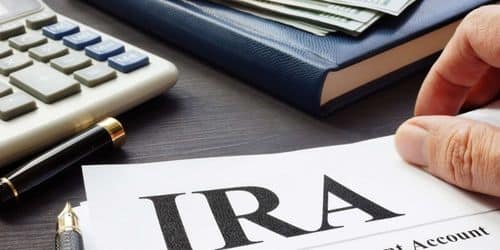A backdoor Roth IRA is a method of saving for retirement in which you contribute to a traditional IRA, which is something anybody can do and then instantly convert the account to a Roth IRA. This article has a clear explanation of the backdoor roth and step-by-step instructions on how to do it yourself. The post also contains some backdoor Roth Frequently Asked Questions that should answer any questions you may have had up to this point.
Backdoor Roth
A backdoor Roth IRA is an unofficial sort of individual retirement account. It’s a way for high-income people who make more than the Roth IRA income limits to change their traditional IRA to a Roth IRA.
The backdoor Roth IRA technique is not tax evasion. You must pay taxes on any funds—principal, earnings, and appreciation—transferred from a traditional IRA to a Roth IRA that haven’t already been subject to taxes.
If the IRA was paid for entirely with tax-deductible contributions, the full value of the assets that were transferred will be taxed.
How Backdoor Roth Works
There are various ways to set up a backdoor Roth IRA, and many businesses that provide IRA services may help to make sure that each step is carried out in accordance with IRS regulations.
The first step is to open and fund a traditional IRA or another IRA type that has no income restrictions.
Doing the conversion is the next step. It is possible to achieve this by converting the regular IRA contributions to a Roth IRA. The annual contribution cap is not applicable in this instance; therefore, the account owner may roll over any amount they like. The account could also be completely converted to a Roth IRA.
The next step is to pay the contribution taxes. Traditional IRA contributions are tax-deductible, whereas Roth IRA contributions are not. As the Roth conversion is not a way to avoid paying taxes, the taxes that were withheld from contributions made to a traditional IRA must be paid when money is transferred to a Roth IRA. On the third stage, the IRS employs a pro-rata rule.
The taxes owed on rollovers from a traditional account to a Roth IRA are based on the ratio of the traditional account’s pre-tax and after-tax parts. For instance, 40% of the funds in a regular IRA are after-tax, and 60% are pre-tax.
The traditional IRA may have already realized gains from the investments of the contributions before being converted into a Roth IRA. For a regular IRA, the profits in this case are taxed, so the account holder must also pay taxes on the Brokerages usually tell account holders to start the conversion phase as soon as the account starts to make money, or “produce gains.”ak.
How to Create a Backdoor Roth IRA
An instruction manual for performing a backdoor Roth IRA conversion is provided below.
- Contribute funds to a regular IRA. You might need to open an account and fund it if you don’t already have one. See our selections for the top IRA providers if you need to open an account.
- Your donation can be changed to a Roth IRA. The guidelines and documentation will be provided to you by your IRA administrator. Throughout the conversion procedure, if you don’t already have a Roth IRA, you’ll create one. Several of the financial advisors NerdWallet assesses offer their clients some amount of assistance with arranging backdoor Roth conversions if you’d prefer to delegate this task to someone else.
- Get ready to pay taxes. Roth IRAs accept only after-tax funds. You must return the tax deduction if you converted your traditional IRA after choosing to deduct your traditional IRA contributions. Be ready to pay income tax on the funds you converted to a Roth when it comes time to file your tax return. The pro-rata rule, which significantly affects how much tax you owe, is discussed in more depth below.
Benefits of a Backdoor Roth
Why would taxpayers want to go through the extra trouble of performing the IRA dance, besides getting around the limits? There are many justifications.
- One benefit of Roth IRAs is the absence of required minimum distributions (RMDs), which permits tax-deferred development of account balances for the duration of the account holder’s life. You are free to withdraw any amount, whenever you wish, or you can leave the entire balance to your heirs.
- A backdoor Roth contribution can result in significant tax savings over a number of years because, unlike standard IRA distributions, those from a Roth IRA are not subject to federal income tax.
- As with Roth IRAs in general, the fundamental benefit of a backdoor Roth IRA is that you pay taxes on your converted pretax assets up front; everything else is then tax-free.
Mega Backdoor Roth
Mega backdoor roth has limits, but it’s a terrific way to increase the amount of money growing tax-free. Investors must be making after-tax contributions to a qualified 401(k) or 403(b) plan in order to invest. Investors should check with their plan administrator to determine if this is possible to set up because not all plans permit it.
Post-tax contributions to a massive backdoor Roth IRA are tax-free. When you withdraw money to deposit into your Roth IRA, only investment gains on after-tax contributions are taxed at your current income tax rate. As we explain below, this advances it to the next stage. For those who have a 401(k) plan through their employer, they can roll over up to $43,500 in post-tax funds into a mega backdoor Roth, which can be either a Roth IRA or Roth 401(k), in 2023.
How a Mega Backdoor Roth Works
Your 401(k) contribution limit under the mega backdoor Roth is $66,000 in 2023. What’s the total here? 2023’s standard 401(k) contribution is $22,500 ($30,000 for those age 50 and over). If your employer doesn’t offer a match, you can put an extra $43,500 into your 401(k) after taxes. In the event that you do receive an employer match, you must subtract your employer’s contributions from the $43,500.
The mega backdoor roth shines brightest here. You can roll over your post-tax contributions into a Roth IRA using the Roth option. In principle, you can decide whether the Roth 401(k) or a Roth IRA will get your mega contributions if your employer’s Roth 401(k) plan permits the mega option, as explained below. Your massive contributions would go into a Roth IRA if your workplace only offered a standard 401(k). For the optimum massive backdoor Roth plan, you need to have the following in place:
- a “after-tax contribution” 401(k) plan. Your after-tax contributions are a different type of contribution than your standard and Roth 401(k) contributions. You have already paid taxes on the money you deposit in an after-tax bucket because it is post-tax.
- distributions made while in use. Your employer must allow you to move assets from the 401(k) plan’s after-tax portion into the Roth 401(k) section or give in-service distributions to a Roth IRA. Ask your human resources department or plan administrator if you’re unsure.
- cash on hand. Even after maxing out your standard 401(k) and Roth IRA contributions, you still have money to save.
Investors must pay close attention to the rules so they don’t accidentally cause a taxable event.
Benefits of a Mega Backdoor Roth
- No tax repercussions: Since it is supported using after-tax dollars, investors have already paid taxes.
- Increased Roth IRA contribution allows contributions to a Roth IRA of more than $6,000 per year.
- enables Roth for persons who would not otherwise be eligible: The backdoor Roth circumvents the rigorous income requirements for Roth IRAs.
Is Backdoor Roth Still Allowed in 2023?
Yes, Roth IRAs with a backdoor are still allowed in 2023. But if the suggested changes to the law are made, the Roth backdoor method will no longer be used.
When Should You Not Do a Backdoor Roth?
A backdoor Roth that results in a tax bill might not make sense if your current federal income tax rate is high but you anticipate that your retirement income will be significantly lower.
Robinson warns that even if you expect less income, the federal government may raise tax rates to reduce the deficit.
Who Cannot Do a Backdoor Roth IRA?
Your client must be at least 70 years old in order for the back-door Roth IRA to be valid. The reason for this is that standard IRA donations have an age restriction. Traditional IRA contributions, whether deductible or not, are not allowed in the year you reach the age of 7012 or later. The back-door Roth IRA technique cannot be used by clients who are over the age restriction. Despite the fact that Roth IRAs have no age restrictions, the actual IRA contribution is going into a standard IRA, not a Roth IRA, thus this won’t assist
Can I Do a Backdoor Roth if I Have a Traditional IRA?
By using a standard IRA, a backdoor Roth is possible. Contribute to an existing traditional IRA and roll it over to a Roth IRA. Even if your traditional IRA has more than the annual maximum, you can transfer it completely to a Roth.
Who Is Eligible for Mega Backdoor Roth?
In 2023, employees with 401(k) plans can roll over $43,500 in post-tax funds into a huge backdoor Roth, either a Roth IRA or Roth 401(k). (k). Before making a substantial backdoor Roth at home, consult a financial adviser or tax professional. It’s hard, has a lot of moving parts, and could lead to tax bills you didn’t expect.
Conclusion
Do the math and think about the tax ramifications if you’re thinking about employing the backdoor Roth IRA technique, especially if you’re converting the full balance of a regular IRA. You may owe a sizable sum of money in taxes.
Even so, the backdoor Roth IRA method could be helpful, especially for people with high incomes. RMDs are not required for Roth IRAs, allowing you to keep them forever and leave them to your heirs. Its contribution can result in significant tax savings over the years since, unlike standard IRA distributions, those from a Roth IRA are not taxed. This is another benefit.
Related articles
- ROTH 401(K): Withdrawal Rules and Comparisons
- Best Ways To Invest Money: Top 7 + Options In 2023 & Best Practices
- TAXABLE BROKERAGE ACCOUNT: Understanding Taxable Brokerage Account And How It Works
- 401k BENEFITS: 2023 401k Benefits for Employees and Employers(+Detailed Guide)






